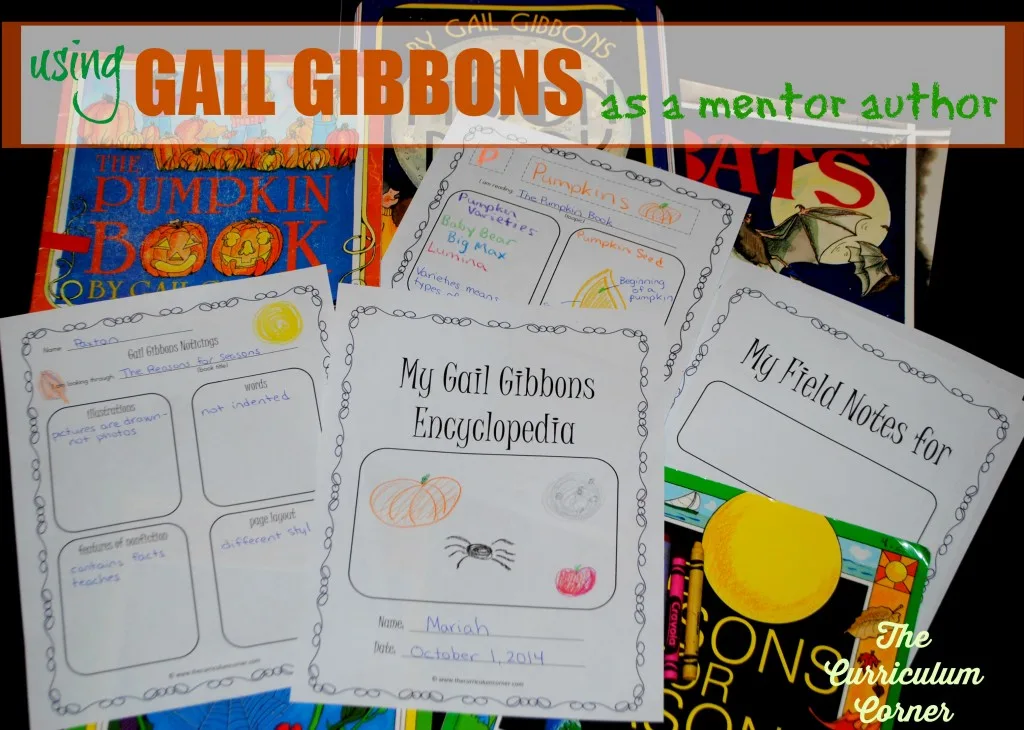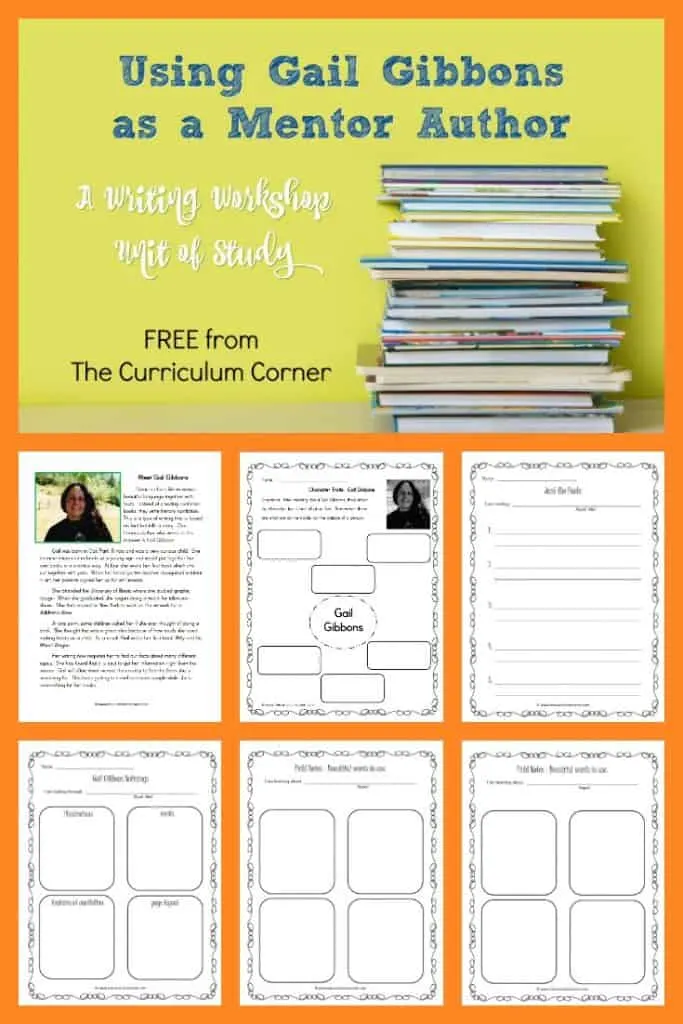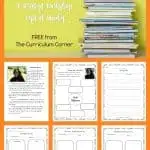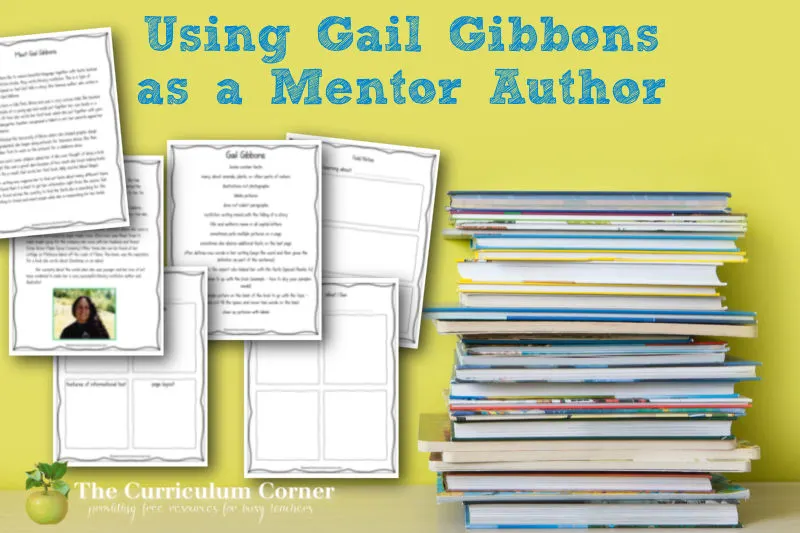This collection of free resources for writing workshop is designed to help you create an author study on Gail Gibbons in your classroom
This collection will help you use Gail Gibbons as a mentor author.
Your students will love exploring this author as they learn to become authors.
This is another free resource for teachers and homeschool families from The Curriculum Corner.
Why We Chose Gail Gibbons
A newer unit of study our district has incorporated into our writing workshop over the last couple of years is literary nonfiction.
Weaving facts with storytelling can be a difficult concept for young authors to apply to their own writing.
We believe that the best approach is immersing children in good examples of this writing style. One of our favorite authors when it comes to literary nonfiction is Gail Gibbons.

Getting Ready
Before beginning this study, we like the idea of putting together an exploration center centered around her work. Include a large selection of books written by Gibbons. We also suggest including travel brochures as she likes to research her topics by going to the source. Maybe add a map!
Include beautiful items from nature such as leaves, small pumpkins and other items that fit with her books. Provide yarn for binding books as Gail once did along with other materials that could be used in writing books like hers.

Please Note: You will find that many of the lessons below will stretch over two or three days.
The materials provided within this free unit of study are provided as individual downloads. You can access each resource by clicking on the bold titles of each resource. As this is an older unit of study, it is not available as a single download.
Lesson 1: All About Gail Gibbons
We like beginning a study on Gail Gibbons with helping the students learn about her life. Her web site is one source for this task: www.gailgibbons.com.
Within the download you will find a two page biography along with a character traits organizer.
Children can read about the author on her site or in the included biography.
Next, they can focus on character traits.
You can also use this introduction to encourage children to create their own I Wonder questions about Gail Gibbons.
They should focus on what they would like to know to understand her better as an author.
Your class might even turn this into an anchor chart they can reference throughout the study.
Lesson 2: Noticings
Noticings are a great way to introduce a writing approach to students.
The idea is that children are given a stack of books that fit the theme. In this case, you would supply students with a range of books by Gail Gibbons.
Students go through the books to see what they “notice” about Gail’s writing style. (If writing workshop is new to you, start here to learn more about noticings: Launching your Writing Workshop.)
I often have students mark books with post-it notes. If your authors would prefer a graphic organizer, there is one provided in the download.
It is important to encourage children to focus on the style and not the words. It can be very difficult for children to begin to look deeper into the writing and not report facts.
This skill takes practice so be patient when you first introduce the idea.
If it is your first time asking your students to do noticings, you might share a book aloud and work through the ideas together. You can allow students to explore farther in small groups.
There is a sample anchor chart of noticings in the download but you can also choose to create one as a class.
Lesson 3: Just the Facts
Gail Gibbons books can be a good source for information as you are studying a new topic in the classroom.
Help students see that facts are woven into her writing by using one of the recording pages.
You will find two different options on pages 6 and 7.
Depending on the age of your students, you might complete one of the pages during your mini-lesson with the students.
Older students might work with partners or individually to complete their own page.
Lesson 4: My Gail Gibbons Encyclopedia
Gail Gibbons writes about an endless number of topics.
You can have students create their own encyclopedia with what they learn as they explore her books.
This can even be done during a literacy center.
Students will need a cover page (page 8) and then recording pages (page 9).
The box on the top left is for the letter the topic starts with and to the right, have students record the topic.
When students have completed their pages, they can alphabetize and staple.
This could even be used as a resource for facts when students are writing.
Lesson 5: Taking Field Notes
Gail Gibbons doesn’t just research from her computer and by reading books, she gets out and talks to experts on the subject she is writing about.
Plan an excursion for your students so that they may practice researching their own topics.
Or, ask families to go on their own outing to allow their children to research a topic that he or she chooses.
Either way, you can use our field notes booklet to get your students started.
First, there is a cover page (page 10) for students to use when creating their research booklet.
Next, choose to use pages 11 through 13 or page 14.
This is where students begin thinking about their own writing.
They can share facts they would like to use and what they learn from experts. Also, they can share language to use. This is where they are closely looking at what Gail Gibbons has done and finding ways to use words in similar ways.
Lesson 6: Standing on the Shoulders of Gail Gibbons
The final step is to have children begin their own writing. They can use your study to create their own books.
Lesson 6: Standing on the Shoulders of Gail Gibbons
Using their field notes, students use what they have learned about Gail Gibbons to write their own book about their chosen topic.
Have children use our blank books: Blank Books for Writing Workshop.
They will then take their planning and work to be authors.
You can download this writing workshop resource here:
Some of our favorites (contains affiliate links):



Karen
Thursday 9th of October 2014
Gail Gibbons's books are so perfect for the 2nd grade classroom. We have just finished reading her pumpkin and vegetable books. Thank you for including this. It is wonderful.
Barbara Marshment
Friday 3rd of October 2014
I so want to teach this unit. My students love Gail Gibbons's books and so do I. We often use her work as an example of "how-to" writing, which never fails to engage even our most reluctant writers. If you choose me as a winner, I would love to receive a copy of Ladybugs, Owls or Beavers!
Kristen
Thursday 2nd of October 2014
Gail Gibbons is, by far, my FAVORITE science book author for kids. I go to her first for any science lesson I present, as she defines and clarifies things so well for kiddos. My favorite is Earth Inside Out. I would love a copy of The Pumpkin Book for my collection. Thanks for this great author study!